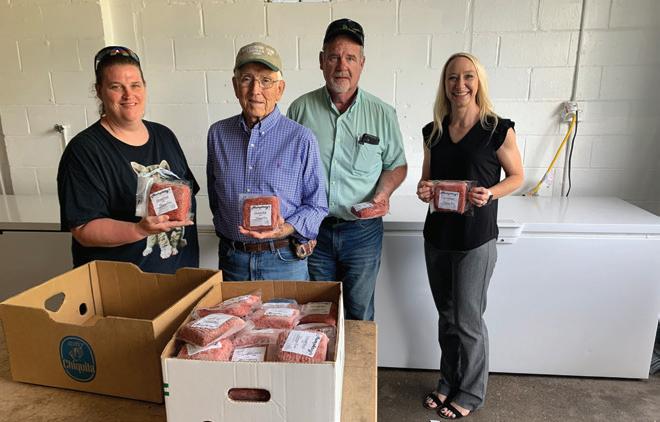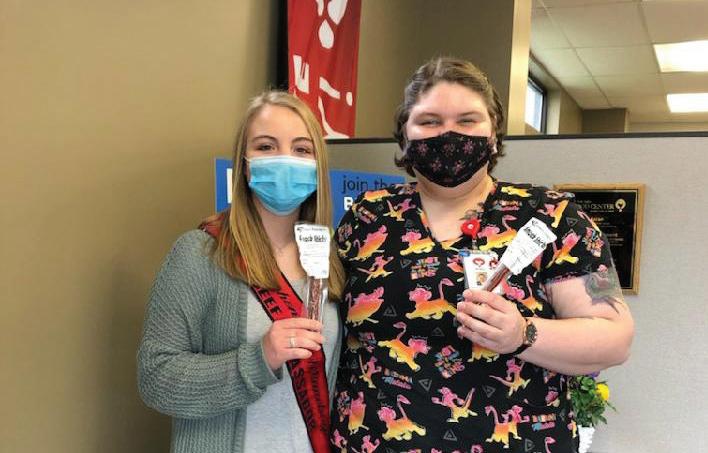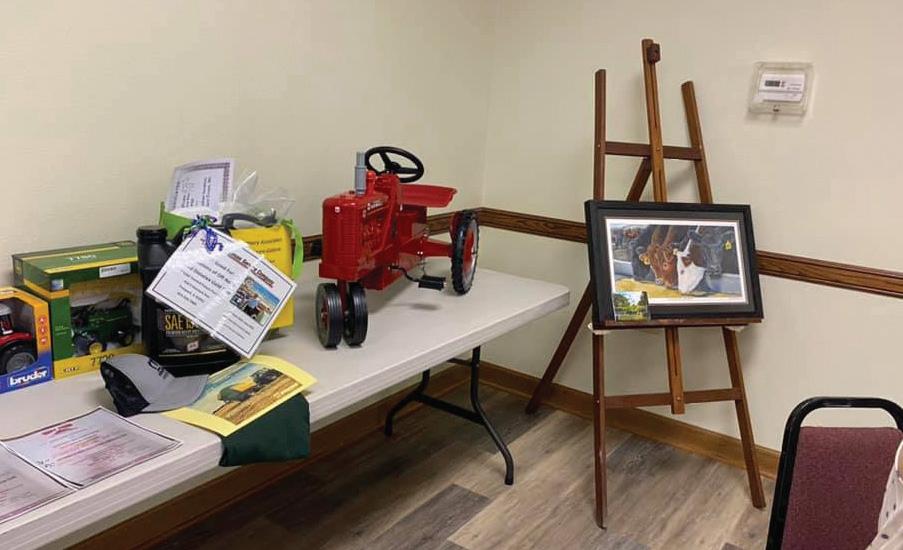
13 minute read
Gate Cuts
Paul Walker, DI Walker Consulting
OUR SYSTEM IS BROKEN: Three Black Swan Events Exacerbate the Problem
Advertisement
Our finished cattle marketing system has an hourglass shape – many feedlot operators at the top selling fat cattle to a few beef packers in the middle, who merchandize beef to many purveyors, distributors and retailers at the bottom. This phenomenon creates two supply/demand curves - one for live cattle and one for retail beef, creating a disconnect between the cattle selling business and the beef merchandizing business. As cattle producers, we like to think and promote the idea that we are in the beef business, but one could make the case that the hourglass affect has effectively made the feedlot operators customer the packer not the consumer, regarding marketing and pricing. This is not where we want to be as an industry - but it could be reality if we are not careful.
You have heard the saying “the swine industry follows the poultry industry, and the cattle industry follows the swine industry.” Concentration and vertical integration within an industry are generally the result of a slow, gradual process, with one or two dynamic events that speed up the process. As an example, the swine industry has been concentrating and vertically integrating since the 1960’s. The swine industry’s Black Swan event occurred in 1998 when the value of market hogs went to essentially zero. Many farrow to finish family operations left the swine industry or became contract growerfinishers for large integrators.
Concentration within the cattle feedlot sector began in the late 1950’s and early 1960’s with the development of the interstate highway system. Several factors have affected concentration of the feedlot sector over the 60 years since then. A perfect storm occurred in the mid 1970’s (1973-1977) that hastened the exodus of farmer-feeders. This perfect storm included: 1) the corn blight and $3:bu. corn, 2) closing of the nation’s stockyards, 3) the oil embargo and gasoline shortages/high gas prices, 4) grocery store butcher strikes/ high meat prices/consumer boycotts, 5) the all-time peak in U.S. cattle numbers/low cattle prices, and 6) Earl Butz, U.S. Secretary of Agriculture, encouraging farmers to plant grain “fence-row to fence-row.” Many Midwest cattle feeders exited the feedlot business because they had lost enough money. Hence, drive down any two-lane highway in Illinois today, and see all the vacant cattle barns, shining concrete lots and empty silos.
For decades, a persistent dilemma has attacked the cattle feeding industry - consistent profitability or lack of it. High feed costs, high feeder cattle costs, increased environmental regulation, high labor costs, fewer but larger packers, limited numbers of bids for finished cattle and other factors have all contributed to concentration of cattle feeding in the southern high plains states, and to the decline in Midwest cattle feeding operations. Also, a change in how cattle are marketed has been a contributing factor as to who feeds cattle. Basically, there are four methods for marketing cattle in addition to using futures or options as a marketing strategy. They are cash, basis, forward-contract and formula-pricing. In addition, there are several forms of each of these methods that can be utilized. For example, regarding cash, one can sell finished cattle via live auction or video/internet auction, negotiated direct-to-packer sales on a carcass grid basis, negotiated direct-to-packer sales on a live basis, or negotiated direct-topacker sales on a dressed basis. Over time, fewer cattle have been marketed via cash and more cattle are being marketed through forward-contracts or on a formula method (often referred to as alternative marketing methods or A.M.M.). One of the problems is that forward-contracts and formulapriced cattle value are based on cash cattle prices, and ...fewer and fewer cattle are sold on a cash basis for which to establish formula and forward-contract values. It is interesting that in Illinois nearly one-half the finished cattle are sold on a cash basis.
Regardless of the method utilized for establishing the value of finished cattle, the ratio of beef cutout price the packer receives to the live cattle price the feeder receives has been increasing overtime. Historically, the ratio of wholesale cutout price ($:cwt) to cash fed-cattle price ($:cwt) has ranged between 1.40:1 to 1.60:1. I cite the average price ratio for the week of Nov. 20-26 for the years 2010 to 2015 that ranges from 1.50:1 to 1:62:1 (refer to Table 1). Since that time, the ratio of beef cutout value to live cattle price has steadily increased overtime, meaning the feeder has been getting a smaller share of the dollar as the packer has been betting a larger share. As Table 1 shows, I have listed the average monthly ratio of beef cutout price to live cattle price form Jan. 2016 to March 2021. Table 2 shows the ratio by day from April 16, 2021 to June 15, 2021. Accordingly, the data shows that from the fall of 2020 (post-COVID-19) to April 15, 2021, the ratio has increased from around 1:60:1 up to over 2.20:1. Since August of 2019, three Black Swan events have exaggerated the ratio. The first Black Swan event occurred between August 2019 to Nov. 2019 and coincides with the Tyson Packing House fire in Holcomb, Kan. that occurred in late August. During this time, the ratio increased to 2.1:1. The second Black Swan event occurred between March 2020 to Sept. 2020 and coincides with the initiation of the COVID-19 pandemic. During this time, the ratio increased to 2.40:1. Following this seven-month period, the ratio of cutout price to live cattle price seemingly established a new normal
TABLE 1: RATIO OF BEEF CUTOUT PRICE ($:CWT) TO LIVE CATTLE CASH
SOURCE: USDA DATAMART NAT. WEEKLY BOX BEEF CUTOUT/NEGOTIATED CASH SALES
DATE BEEF CUTOUT LIVE CASH RATIO DATE BEEF CUTOUT LIVE CASH RATIO
3/26/2021 234.78 114.93 2.05/1 4/20/2018 211.78 125.41 1.69/1 2/26/2021 240.39 113.86 2.11/1 3/23/2018 224.18 127.86 1.75/1 1/29/2021 230.28 110.38 2.09/1 2/23/2018 216.53 123.4 1.75/1 12/23/2020 209.71 108.56 1.93/1 1/26/2018 206.7 120 1.72/1 11/20/2020 234.51 108.56 2.16/1 12/22/2017 200.14 121.49 1.65/1 10/23/2020 209.03 106.36 1.97/1 11/24/2017 208.7 112.65 1.85/1 9/25/2020 216.87 104.01 2.09/1 10/20/2017 198.63 107.04 1.86/1 8/21/2020 222.49 105.13 2.12/1 9/22/2017 191.98 111.55 1.72/1 7/24/2020 201.56 97.16 2.07/1 8/25/2017 192.3 118.65 1.62/1 6/26/2020 210.2 103.76 2.03/1 7/21/2017 207.88 128.67 1.62/1 5/22/2020 405.4 112.06 3.60/1 6/23/2017 244.9 137.36 1.78/1 4/24/2020 272.33 100.89 2.70/1 5/26/2017 246.28 131.35 1.88/1 3/20/2020 243.03 112.56 2.16/1 4/21/2017 215.63 127.14 1.70/1 2/21/2020 205.71 118.57 1.73/1 3/24/2017 223.12 120.86 1.85/1 1/24/2020 214.78 124.09 1.73/1 2/24/2017 194.48 119.9 1.62/1 12/20/2019 211.63 120.15 1.76/1 1/20/2017 191.65 113.83 1.68/1 11/22/2019 236.75 115.3 2.05/1 12/23/2016 197.23 108.62 1.82/1 10/25/2019 223.08 109.49 2.04/1 11/25/2016 186.3 101.48 1.84/1 9/20/2019 218.75 102.88 2.13/1 10/21/2016 179.99 106.16 1.70/1 8/23/2019 239.87 110.25 2.18/1 9/23/2016 186.48 116.73 1.60/1 7/26/2019 213.09 113.95 1.87/1 8/26/2016 200.34 117.55 1.70/1 6/21/2019 220.9 117.86 1.87/1 7/22/2016 201.39 123.29 1.63/1 5/24/2019 220.64 125.79 1.75/1 6/24/2016 216.82 128.9 1.68/1 4/26/2019 233.49 127.58 1.83/1 5/20/2016 225.72 129.85 1.74/1 3/22/2019 228.95 124.7 1.84/1 4/22/2016 222.27 136.92 1.64/1 2/22/2019 228.98 123.05 1.86/1 3/25/2016 226.62 133.69 1.70/1 1/25/2019 217.72 119.51 1.82/1 2/26/2016 216.51 133.95 1.62/1 12/21/2018 216.71 115.19 1.88/1 1/22/2016 228.73 124.73 1.83/1 11/23/2018 212.71 111.95 1.90/1 11/20/2015 206.41 127.44 1.62/1 10/26/2018 213.76 109.91 1.96/1 11/21/2014 254.78 170.3 1.50/1 9/21/2018 211.5 110.49 1.91/1 11/22/2013 199.28 131.68 1.51/1 8/24/2018 213.86 112.1 1.91/1 11/23/2012 194.92 126.03 1.55/1 7/20/2018 204.32 110.24 1.85/1 11/25/2011 196.64 123.91 1.59/1 6/22/2018 218.65 119.04 1.84/1 11/26/2010 161.01 99.8 1.61/1 5/25/2018 229.34 120.74 1.90/1
around 2.05:1. The third Black Swan event began in April 2021 and is occurring as I write this article. Since April 16 through June 15, the average daily ratio of cutout price to live cattle price has been 2.60:1 - and what is the cause of this third Black Swan event? I do not know, maybe several factors: the COVID-19 pandemic effect is not over, packing plants cannot run at full capacity due to labor shortage, shortage of shackle space (not enough packing house capacity), backlog of heavy-weight finished cattle, too many cattle sold via forward-contract decreasing the need for packers to purchase live cattle, driving the price of cash cattle down? As example of the last factor, during the week of May 3, 2021 one major packer announced they would not buy any cattle from sale barns to help eliminate the backlog of customer cattle. During the week of April 26, 2021, regarding seven packing plants in the southern U.S., only 2 days kill consisted of cash cattle.
If the new normal ratio of cutout price to live cattle cash price is in the 2.20:1 plus range at a time when consumer demand for beef is high, then the finished cattle marketing system is broken, and the industry needs to face this situation head-on and work for a proactive solution. According to Alkin Kalo, chief economist at Steiner Consulting Group, in a Drovers Daily article by Greg Henderson (2019), “Beginning
DATE BEEF CUTOUT AVG LIVE CASH AVG RATIO DATE BEEF CUTOUT AVG LIVE CASH AVG RATIO
4/16 276.05 125 2.21:1 5/17 319.62 120 2.66:1 4/19 276.16 123.04 2.24:1 5/18 323.34 121 2.67:1 4/20 278.26 120 2.32:1 5/19 323.38 121.25 2.67:1 4/21 280.46 123 2.28:1 5/20 324.18 121.15 2.68:1 4/22 282.31 123 2.30:1 5/21 325.17 120 2.71:1 4/23 283.77 122 2.33:1 5/24 327.83 120 2.73:1 4/26 285.2 120 2.38:1 5/25 329.92 121 2.73:1 4/27 290.99 119 2.43:1 5/26 329.49 121 2.75:1 4/28 292.5 119.5 2.45:1 5/27 329.98 122 2.71:1 4/29 293.76 119.57 2.46:1 5/28 330.97 117 2.83:1 4/30 296.5 119 2.49:1 6/1 334.56 5/3 299.3 119 2.51:1 6/2 340.16 122.5 2.78:1 5/4 301.22 118 2.55:1 6/3 340.55 121 2.81:1 5/5 304.78 118 2.58:1 6/4 338.98 120.5 2.81:1 5/6 306.37 118 2.60:1 6/7 338.6 120 2.82:1 5/7 305.88 118.2 2.59:1 6/8 338.61 120.03 2.82:1 5/10 309.11 120 2.58:1 6/9 338.65 122.5 2.77:1 5/11 312.37 121 2.58:1 6/10 338.25 121 2.80:1 5/12 315.08 121 2.60:1 6/11 337.56 121.89 2.77:1 5/13 316.78 120 2.64:1 6/14 335.47 124 2.71:1 5/14 316.94 122 2.60:1 6/15 334.43 123.48 2.71:1
41-DAY MEAN 2.6
in 2018 the relationship between cutout and fed cattle values shifted. Fed-cattle supplies slowly started to increase at a time when beef demand was also on the upswing and packers started to bump up against capacity constraints. The ratio of 1.61:1 was not sustainable due to lack of packer capacity issues.” In 2019 the ratio of cutout to fed cattle was 1.91:1.
On June 3, 2021, the ratio was 2.81:1 (the highest cutout value day of the third Black Swan event). If the ratio was at a historic level of 1.61:1, the price of choice fats should have been $211.52:cwt or the cutout price should have been $192.60:cwt not $340.55 at a $121.00 live cattle price (refer to Table 2). Clearly, as consumer demand for beef is high, the cattle feeder should be capturing a larger share of the consumer dollar. It seems that cash live cattle price should be directly tied to beef cutout value. A direct tie would allow live cattle prices to go up as beef cutout prices go up and the feeder could realize a larger dollar share of consumer demand for beef. Of course a direct tie also would allow live cattle prices to go down as beef cutout value goes down. On the other hand, maybe that function already occurs. The downside is in, the upside is not. Rather than focusing on cash fed-cattle prices and whether-or-not a portion of cash purchases by packers should be mandated, maybe the findustry should be giving serious consideration of other methods to fix our broken fed-cattle marketing system. Maybe we should ask and find answers to some hard questions. Do packers have a monopoly? Should the three largest packers be broken up? Is there any price fixing within the beef sector? How do we directly tie cutout value and cash cattle price together? I do not accept the opinion that the major disconnect between live cattle price and cutout value is due to a lack of shackle space. Rather, I think it could be partly due to slower fabricating line speeds, partially due to COVID-19 prevention strategies, worker absenteeism, low worker pay and possibly a host of other reasons. One could say this is not the cattle persons problem, but it is if packers are making money under the current scenario and cattle producers/feeders are not. Packers buying more cattle in the cash market may/may not be part of the answer, but I suggest it is not the whole answer. I suggest the industry needs to turn its discussion away from mandating cash purchases by packers to directly linking cutout value to live cattle price. The cattle industry through its member organizations needs to ask a lot of questions and get some solutions quickly or we will have another Black Swan event like the industry suffered in the 1970’s.
If it makes anyone feel better, the cattle/beef industry is not alone. The lumber industry has similar problems, but their issue is primarily one of labor. Retail lumber prices are high because retail demand is high due to a housing boom. Logging prices are low due to lack of demand for logs by mills because mills cannot find enough labor to cut the logs.
NOTE: The opinions expressed in this article are those of the author and do not necessarily reflect the views of Illinois Beef magazine nor of IBA.


Affiliate News
Heartland Beef Alliance
Heartland Beef Alliance and Mason County Farm Bureau collected ground beef donations on May 20.



Stephenson/Winnebago County Beef Association
The Stephenson/Winnebago County Beef Association donated beef sticks to the blood center for May Beef Month. Each donor received a beef stick as part of the promotion. Beef sticks were also donated to participants of the Bruce Johnson Memorial Farm to Farm 5K/10K Run in March.


JoDaviess County Beef Association
300 people attended and supported the JoDaviess County Beef Association at their scholarship and beef promotion auction. A prime rib dinner was served and over $24,000 was raised.


Knox County Cattlemen’s Association
The Knox County Cattlemen’s Association held a grocery store giveaway event in honor of May Beef Month.
The Henry County Beef Association awarded scholarships and awards during their annual Banquet in June. Scholarship recipeints include Bree Olson and Brooke Jackson. Junior ambassadors Ella Jeffries, Madeline Nightengale, Kyla Derycke and senior ambassador Kaden Davison were all in attendance. Awardees left to right: 2021 Young Producer: Devin Olson 2020 Lifetime Achievement: Benny Kuster 2019 Outstanding Member: Ron Grymonprez 2020 Outstanding Member: Brad Bates President: Chad Horsley 2021 Beef Backer: Mike Nordstrom 2021 Friend of the Industry: Wilbur Nelson 2021 Lifetime Achievement: Dean Olson

Prarie Beef Association
The Prarie Beef Association sponsored a billboard on Highway 51 to support beef. They also are sponsoring several livestock shows this summer. Prairie Beef would also like to congragulate Grace Arnold on being selected as IBA Outstanding Junior of the Year. Katie Sellmeyer was a speaker on the Marketing Beef Direct to Consumers panel at the IBA Summer Conference. The Summer Cattlemen’s Picnic is TBD and infomation will be mailed to all members.

Tri-County Cattlemen’s Association
The Tri-County Cattlemen’s Association Affiliate Banquet and Educational Tour is set for Saturday, August 28 at the Warren County Fairgrounds-Roseville. Schedule includes: Depart the Warren County Fairgrounds at approximately 2:00 p.m. Stop #1: Earlybird Nutrition, LLC Roseville Facility Tour & Nutrition Representatives Stop #2: Strickler Farms - Producer Perspective, Facility Sighting and Manure Management Return to Warren County Fairgrounds at approximately 5:00 p.m. for Social Hour, Ribeye Meal, Live Auction and Country Musician Eric Burgett. Ticket information will be available in the coming weeks. Follow their Facebook page for the most up to date information. Sponsorships are available by contacting tricountycattlemen@gmail.com or Alison McGrew at 309-337-0687.
Affiliate News
Do you have Affiliate News? Submit information to Betty Haynes at betty@illinoisbeef.com or 217-787-4280. Please notify Betty as changes to affiliate officer teams are made for our records.









